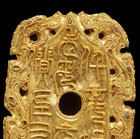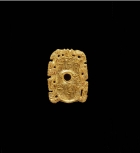J.J. Lally & Co., Oriental Art / New York City, New York
MenuPast Exhibition
Bronze and Gold in Ancient China
March 24 - April 12, 2003
21.
AN INSCRIBED AND INLAID GOLD OPENWORK PLAQUE
Xin Dynasty (A.D. 9-23)
the shield-shaped panel pierced with a central aperture and decorated on both sides with an auspicious inscription of eighteen characters applied in gold wire, and with twin dragons with openwork serpentine bodies extending down each side, the dragons’ heads emerging on either side of the pointed tip of the panel, the outer edges embellished with a running band of tiny lozenges formed of gold wire and filled with gold granulation, and the dragons’ bodies covered with scroll motifs in gold wire edged with granulation and interspersed with teardrop-shaped gold wire chambers for inlay, a few retaining original turquoise and other hardstone inlays, others vacant, and several showing remains of cinnabar red pigment, the dragons’ heads each with tiny chambers of gold wire for the eyes, nostrils and horns, and with extensive granulation covering the surface of the head, the outline of the panel and the central aperture also with borders of gold wire and granulation, some traces of earth from burial.
Length 2 1⁄8 inches (5.4 cm)
The inscription may be read as “Qian qie yuan laomu yuannan gui zuo you. Chang xing xu cun shi mong xiu en” which may be translated as: “May you have many concubines and may your elderly mother and eldest son be wealthy and respectable. May you always have someone to take care of you and may you enjoy a gentle retirement.”
The reading and translation above were provided by Professer Rende Hua, research librarian at the Suzhou University Library and Professor Qianshen Bai, Boston University.
The form and style of this plaque is consistent with excavated materials found in Xin dynasty and early Eastern Han burial sites, and the specific characters in the inscription found on this plaque show a distinct usage which first appears in the Xin dynasty. The usurper Wang Mang changed the name of the capital city Changan 長安 to Changan 常安 , and so the characters used in the phrase “Changxing”, which was written 長 in the Western Han period appears written as 常 in the Xin dynasty. The first two characters of the inscription on one side of this gold plaque: “Changxing” written as 常幸, show this new usage, an innovation uniquely associated with the Xin Dynasty, and so a Xin dynasty date is indicated for this plaque.
The form of this plaque is based on the form of a jade archer’s ring called a jue in Chinese texts which first appeared in the Zhou dynasty as a useful part of an archer’s equipment. In the later Eastern Zhou ceremonial jade archer’s rings of more elaborate form came into fashion and by the Han Dynasty the form had become even more fanciful and elaborate and the purpose of the plaque was purely ornamental.
Han dynasty gold ornaments are extremely rare and no other Han gold plaque of this form has been previously published, but the form is well known in Han jade. A jade jue pendant with a pair of openwork dragons, from the Sonnenschein Collection, now in the Art Institute of Chicago, is illustrated by Watt in Chinese Jades from Han to Ch’ing, New York, 1980, no. 156, p. 180, where the author gives a concise explication of the evolution of the shape and cites another Han jade plaque of this shape which was discovered in Changsha, Hunan in a tomb assigned to the period of the usurper Wang Mang, also referred to as the Xin dynasty (A.D. 9-23), published in Wenwu, 1960, No. 3, p. 24, fig. 24 together with numerous other jade, hardstone, glass and gold ornaments found at the same site including a vase-shaped gold pendant, ibid, fig. 8, decorated with inlays, gold wire and granulation in the same technique as the present example.

